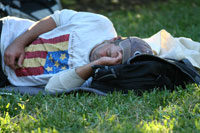
Residents, business owners complain to city commission about lack of laws, safety problem
By Adrienne Sakyi
There are over 900 homeless individuals in St. Johns County at any given time. The homeless population has been a controversial subject for years in St. Augustine with the debate swirling around the only shelter in the county — the St. Francis House. Concerns about safety and tourism have students, organizations and city officials considering different options for meeting the tremendous need.
The city is entertaining a wide range of solutions to the increasing needs of the homeless population. According to Paul Williamson, director of public affairs for the City of St. Augustine, there has been a “real resurgence recently in homeless population.” Williamson said business owners, residents and tourists have e-mailed the city commenting on the increasing presence of homeless individuals.
According to Sgt. Barry Fox, Public Information Officer for the City of St. Augustine Police Department, unless the city commission passes a new ordinance, the homeless individuals on St. George Street and in the plaza are not committing any crimes.
“We can only enforce things that are violations of laws,” Fox said. “Being homeless is not a crime.”
Some local businesses say the police should monitor the shelter better.
“The shelter is trying to meet a major need in our community, but I do feel like police presence could be stepped up,” Teresa Segal, manager of Absolute Americana Art Gallery said.
Organizations like the Lincolnville Neighborhood Association, Greater St. Mary’s Missionary Baptist Church and the Lincolnville Crime Watch are constantly lobbying to move the shelter.
In a letter to the members of the city and county commission, Pastor Byron Hodges of Greater St. Mary’s Missionary Baptist Church said, “The whole community is tired of people trashing, urinating and defacating on our properties and in our faces. This says nothing of the people sleeping and loitering all up and down the sidewalks.”
Employees at the St. Francis House claim that the real complaint from opponents of the shelter is the presence of homeless individuals in general.
“It’s the fact that there are homeless people in their community,” Pierre Ward, client service coordinator at the St. Francis House, said. “Whether they’re doing anything to the people’s property or not, they’re complaining about the homeless society.”
Lincolnville residents have linked recent crimes like the murder of Thomas Graber to the shelter because the arrested individuals had no known address. Segal said the suspects in the murder ate meals at the shelter and were living in their car on Washington Street. Residents said the individuals were familiar faces in the neighborhood. As a result, safety concerns have been raised by organizations, businesses and students even though police officials insist that the suspects were not homeless or residents of the shelter. “In our definition of homeless, the suspects were not homeless,” Fox said.
Senior sport management major Leigha McDonough works at Sangrias on St. George Street. McDonough recognizes the safety concerns created by a large homeless population. “I think having the shelter downtown is a good thing for the homeless, but I feel a certain nervousness walking through downtown at night by myself,” she said.
Other students like sophomore philosophy major Scott Bufis live in Lincolnville and insist there is no safety concern. “It’s a normal neighborhood,” Bufis said. I don’t think it’s dangerous.”
Many Flagler College students, faculty and employees have expressed their support of the shelter through volunteering at the shelter. Junior elementary education major Chris Bacca helped start Flagler Feeds, which is a partnership between Flagler College clubs and local charitable organizations including the St. Francis House.
“As students we live in such a bubble on campus that we don’t realize that outside of our gates there are people that are starving,” Bacca said. “That’s why Flagler Feeds is an important community service activity.”
Bacca acknowledges the safety risks working with the homeless population at the shelter, but says there have been no safety problems with Flagler Feeds at the shelter.
“Safety was a concern when we did Flagler Feeds for the first time in March,” he said. “There are homeless people who are aggressive — no one is saying there isn’t, but it’s an isolated few.”
Junior English major Wayne Beck, who volunteered with Phi Alpha Delta this semester, agrees.
“I don’t feel threatened by the shelter,” he said. “It’s a good way to have a direct impact on people’s lives.”
Currently the city commission has not made any decisions about ordinances, relocation of the shelter or any other definite course of action for addressing the homeless population situation downtown.


Be the first to comment on "Homeless population continues to grow"